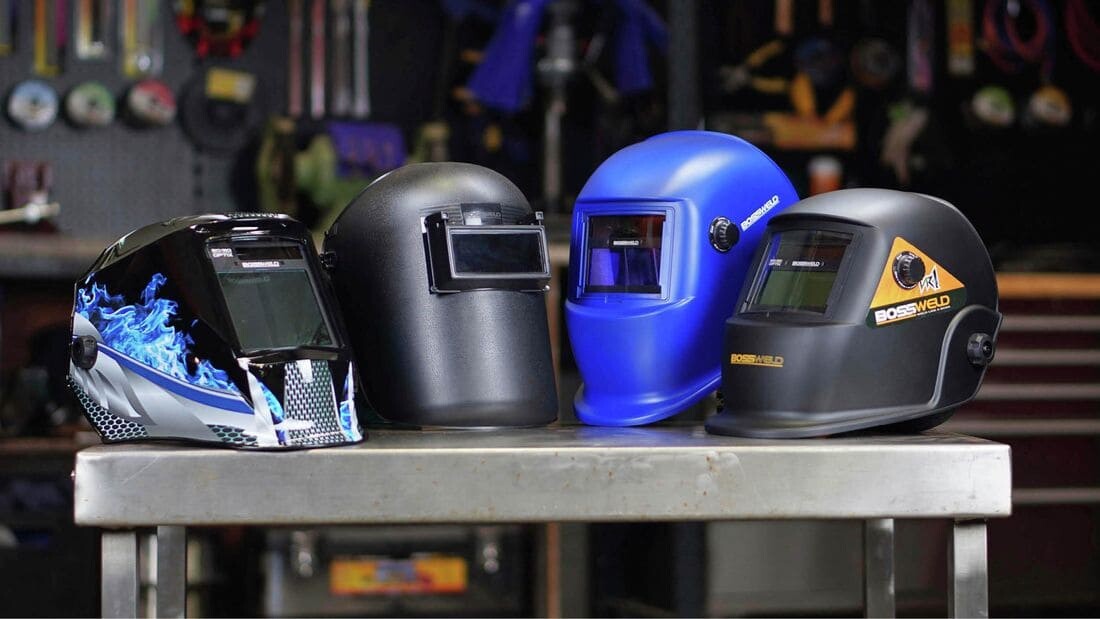Welding helmets are one of the most crucial personal protective equipment (PPE) for welders. They not only protect your eyes from harmful radiation and flying sparks but also directly impact your welding efficiency and comfort. However, with so many welding helmets available in the market, many welders find it challenging to select the most suitable one for their needs. In this guide, we will delve into the key factors to consider when choosing a welding helmet, helping you make an informed decision.

I. The Working Principle of Welding Helmets
During welding, intense radiation, including ultraviolet (UV), infrared (IR), and visible light, is emitted. These radiations can cause severe eye damage, including arc eye (photokeratitis). Additionally, flying sparks and hot debris pose a risk of facial burns. A welding helmet’s primary function is to protect you from these hazards through specially designed lenses that filter out harmful radiation and block flying particles.
The lens of a welding helmet is treated with specialized coatings and darkening to reduce the intensity of harmful light. The lens's "shade level," which ranges from #9 to #13, indicates its ability to filter out light. A higher shade level means greater protection, making it a critical factor in evaluating welding helmets.
II. Key Factors to Consider When Choosing a Welding Helmet
Selecting the right welding helmet involves evaluating multiple factors. Below are the key considerations to help you make the best choice:
1)Safety Standards
Safety should always be your top priority. Ensure the welding helmet meets the American National Standards Institute (ANSI) standards, specifically ANSI Z87.1 – 2003. Helmets that comply with this standard will be marked with “ANSI Z87.1 – 2003” or “Z87+” on the packaging, indicating they have passed rigorous testing for eye protection.
2)Weight
Welders often wear helmets for extended periods, so weight is a critical consideration. High-quality welding helmets typically weigh around 20 ounces. While lighter helmets reduce strain on the neck and head, heavier helmets may still be suitable for amateur or small-scale welding projects.
3)Comfort
A comfortable helmet significantly enhances your welding experience. Look for a helmet that fits snugly without causing skin irritation or discomfort. Additionally, consider breathability to prevent fogging, which can obstruct your view during welding.
4)Viewing Area Size
The size of the viewing area determines your field of vision. A larger viewing area allows for better visibility of the weld pool, improving precision and efficiency. For high-precision welding tasks, opt for a helmet with an expanded viewing area.
III. Fixed Shade vs. Variable Shade Lenses
Welding helmets can be categorized into two main types based on their lens technology:
1)Fixed Shade Lenses
Fixed shade lenses are traditional welding helmets with a permanent shade level (e.g., shade #10). These lenses have built-in IR and UV filters. They are cost-effective and suitable for welding projects with consistent material thicknesses and fixed current settings.
However, a significant drawback of fixed shade lenses is that welders must remove the helmet to inspect the weld, which can disrupt workflow.
2)Variable Shade Lenses (Auto-Darkening)
Variable shade lenses, also known as auto-darkening welding helmets, use advanced technology to automatically adjust the shade level based on the welding conditions. They incorporate:
When not welding, the lens remains in a lighter shade (e.g., #3 or #4) for better visibility. Once welding begins, sensors detect the arc and darken the lens to a higher shade level (e.g., #9 to #13) to protect the eyes.
The main advantage of auto-darkening helmets is that welders can keep their helmets on throughout the welding process, eliminating the need to repeatedly remove and replace the helmets. This feature significantly improves productivity and convenience.
IV. Sensors and Switching Speed
1)Sensors
High-quality welding helmets are equipped with multiple sensors (typically 4 or more) to detect the welding arc from various angles. While entry-level helmets may have only 2 sensors, industrial-grade helmets require more sensors to ensure comprehensive protection during complex welding tasks.
2)Switching Speed
Switching speed refers to how quickly the lens transitions from a light shade to a darker shade when welding begins. A faster switching speed is crucial for professional welders, as slower speeds can lead to eye fatigue. Opt for a helmet with a medium to high switching speed to ensure eye comfort and safety.
V. Versatility
Depending on your welding projects, you might need a helmet with additional features. Consider the following:
Head Coverage: Some helmets offer extra protection for the top of the head.
Expanded Viewing Area: Ideal for high-precision welding tasks.
Multiple Sensors: Ensures protection during welding in complex positions.
VI. Battery Life
Auto-darkening welding helmets require a power source, and the options include:
Internal Non-Replaceable Battery + Solar Assist Panel: Higher cost but longer lifespan.
Replaceable Battery + Solar Assist Panel: Cost-effective and suitable for long-term use.
AAA or Lithium Batteries: Affordable and ideal for daily use.
Conclusion
When selecting a welding helmet, consider your welding project type, duration, skill level, and budget. Below are some recommendations:
For Hobbyists: Fixed shade lenses or entry-level auto-darkening helmets are sufficient.
For Professionals: Invest in a high-end auto-darkening helmet with a larger viewing area and faster switching speed for enhanced efficiency.
For Versatility: Choose a helmet with additional features like multiple sensors and head coverage.
Ultimately, regardless of the helmet you choose, ensure it meets safety standards like ANSI Z87.1 – 2003 and is tailored to your specific needs.
A good welding helmet not only protects your eyes and face but also enhances your welding performance. We hope this guide has provided you with valuable insights to make an informed decision. If you have more questions or need further recommendations, feel free to reach out to us.
Related articles:
1. The Perils of Welding Without Adequate Protection
2. What protective gas should I use for laser welding?
3. Common Dangers of Welding and How to Avoid Them
4. How to Prevent and Control Fire Hazards in Welding Operations?
5. Welding Safety: Hazards, Tips, & Precautions




